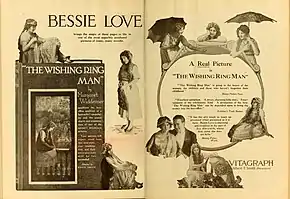Fiancé malgré lui
Fiancé malgré lui (titre original : The Wishing Ring Man) est un film muet américain réalisé par David Smith[1], sorti en 1919. C'est une adaptation du roman de Margaret Widdemer (en)[1] - [2]. Il met en vedette Bessie Love et J. Frank Glendon dans le rôle-titre[1].

| Titre original | The Wishing Ring Man |
|---|---|
| Réalisation | David Smith |
| Scénario | G. Marion Burton, d'après le roman de Margaret Widdemer (en) |
| Acteurs principaux |
Bessie Love, J. Frank Glendon, Jean Hathaway |
| Sociétés de production | Vitagraph Company |
| Pays de production |
|
| Genre | drame |
| Sortie | 1919 |
![]() Pour plus de détails, voir Fiche technique et Distribution
Pour plus de détails, voir Fiche technique et Distribution
Synopsis
Joy Havenith (Bessie Love) est tenue à l'écart des autres jeunes afin qu'elle puisse inspirer la poésie de son grand-père. Elle est mécontente de sa situation, et croit Glendon (The Wishing Ring Man) quand il lui dit que, si elle désire quelque chose fortement, elle obtiendra tout ce qu'elle veut.
Lorsqu'on lui donne l'occasion d'aller à la ville, son grand-père refuse de la laisser sortir, parce qu'elle n'est pas fiancée. Joy prétend être fiancée avec le médecin, et le médecin est obligé de jouer le jeu[3] - [1] - [4].
Fiche technique
- Titre : Fiancé malgré lui
- Titre original : The Wishing Ring Man
- Réalisation : David Smith
- Scénario : G. Marion Burton, d'après le roman de Margaret Widdemer
- Directeur de la photographie : Charles R. Seeling[5]
- Sociétés de production : Vitagraph Company[3]
- Pays d’origine :
 États-Unis
États-Unis - Langue : titres en anglais
- Format : Noir et blanc - 35 mm - 1,33:1 - Muet
- Genre : drame
- Durée : 50 minutes[3] - [6]
- Date de sortie :
Distribution
- Bessie Love : Joy Havenith[1]
- J. Frank Glendon : Dr. John Hewitt
- Jean Hathaway : Mrs. Hewitt
- Claire Du Brey : Gale Maddox
- Truman Van Dyke : Clarence Rutherford
- Willis Marks : le grand-père Havenith
- Alberta Lee : la grand-mère Havenith
- Dorothy Hagan : Phyllis Harrington
- Colin Kenny : Allen Harrington
Sortie
À sa sortie, le film fut projeté avec plusieurs serials et courts-métrages, dont Terror of the Range, de Stuart Paton[7] et la comédie de Harold Lloyd, Coco de Chicago (Billy Blazes, Esq.)[8].
Réception
Le film a reçu des critiques positives[9] - [10], on put relever que Bessie Love a porté dix-sept tenues différentes à travers tout le film[11].
Notes et références
- William J. Reilly, « The Wishing Ring Man », The Moving Picture World, , p. 1388 (lire en ligne)
- (en) Alan Goble, The Complete Index to Literary Sources in Film (lire en ligne), p. 500
- « The Wishing Ring Man is Excellent Attraction », Exhibitor's Trade Review, vol. 5, no 14, , p. 1067 (lire en ligne)
- R.W.B., « The Wishing Ring Man is Excellent Attraction », Exhibitor's Trade Review, vol. 5, no 14, , p. 1067 (lire en ligne) :
« A sweet, charming little story. Entertainment of the wholesome kind. A play that is refreshing. Acting that is delightful. A production of the best. »
- (en) Bessie Love, From Hollywood with Love: An Autobiography of Bessie Love, London, Elm Tree Books, (OCLC 734075937), p. 150
- « Calendar of Program Publications », Exhibitors Herald and Motography, vol. 8, no 13, , p. 54 (lire en ligne)
- « Sheer's Victoria », The Newtown Register, , p. 8 (lire en ligne).
- Daily Leader, Grand Rapids, Wisconsin, 11 octobre 1919, p. 3.
- « Bessie Love at Her Best », The Moving Picture World, , p. 1380 (lire en ligne) :
« Miss Love, in this production, sets for herself a mark which it will not be easy for her to surpass. »
- (en) Strand Theatre, vol. 6, Ellwood City, PA, (lire en ligne), chap. 3, p. 22 :
« rare charm and talent …wonderfully interesting »
- Jack Winn, « Screen Stories with Black Face Comedy », Photo-Play Journal, (lire en ligne)
- (en) Cet article est partiellement ou en totalité issu de l’article de Wikipédia en anglais intitulé « The Wishing Ring Man » (voir la liste des auteurs).
Liens externes
- Ressources relatives à l'audiovisuel :
- (en) AllMovie
- (en) American Film Institute
- (en) IMDb
- (mul) The Movie Database